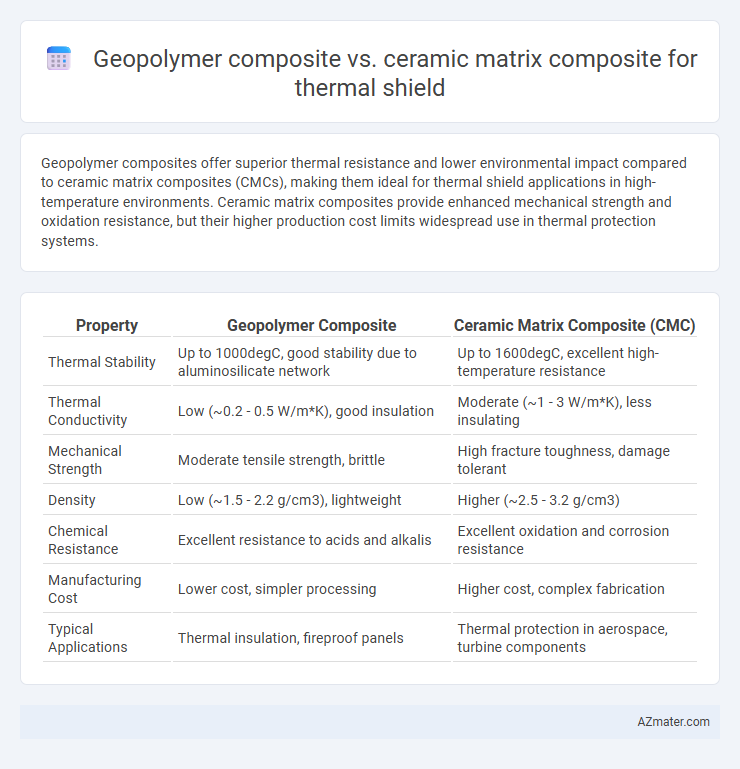Geopolymer composites offer superior thermal resistance and lower environmental impact compared to ceramic matrix composites (CMCs), making them ideal for thermal shield applications in high-temperature environments. Ceramic matrix composites provide enhanced mechanical strength and oxidation resistance, but their higher production cost limits widespread use in thermal protection systems.
Table of Comparison
| Property | Geopolymer Composite | Ceramic Matrix Composite (CMC) |
|---|---|---|
| Thermal Stability | Up to 1000degC, good stability due to aluminosilicate network | Up to 1600degC, excellent high-temperature resistance |
| Thermal Conductivity | Low (~0.2 - 0.5 W/m*K), good insulation | Moderate (~1 - 3 W/m*K), less insulating |
| Mechanical Strength | Moderate tensile strength, brittle | High fracture toughness, damage tolerant |
| Density | Low (~1.5 - 2.2 g/cm3), lightweight | Higher (~2.5 - 3.2 g/cm3) |
| Chemical Resistance | Excellent resistance to acids and alkalis | Excellent oxidation and corrosion resistance |
| Manufacturing Cost | Lower cost, simpler processing | Higher cost, complex fabrication |
| Typical Applications | Thermal insulation, fireproof panels | Thermal protection in aerospace, turbine components |
Introduction to Thermal Shield Materials
Thermal shield materials require exceptional resistance to high temperatures, thermal shock, and mechanical stress, crucial for aerospace and industrial applications. Geopolymer composites offer low thermal conductivity, excellent thermal stability, and environmental sustainability through aluminosilicate-based matrices activated by alkaline solutions. Ceramic matrix composites (CMCs) demonstrate superior high-temperature strength, fracture toughness, and oxidation resistance by reinforcing ceramic matrices with fibers such as silicon carbide, making them ideal for extreme thermal environments.
Overview of Geopolymer Composites
Geopolymer composites are inorganic polymer materials formed by aluminosilicate precursors activated through alkaline solutions, offering excellent thermal stability and resistance to high temperatures above 1000degC. Their low thermal conductivity, chemical inertness, and ability to withstand thermal shock make them ideal for thermal shield applications in aerospace and industrial sectors. Compared to ceramic matrix composites, geopolymers provide a more cost-effective and environmentally friendly alternative with easier processing and lower energy requirements.
Overview of Ceramic Matrix Composites
Ceramic Matrix Composites (CMCs) consist of ceramic fibers embedded in a ceramic matrix, offering exceptional thermal stability and resistance to oxidation at temperatures exceeding 1200degC. These materials exhibit high strength-to-weight ratios and enhanced fracture toughness compared to monolithic ceramics, making them ideal for thermal shield applications in aerospace and high-temperature environments. Their ability to withstand thermal shock and maintain structural integrity under extreme conditions outperforms many conventional composites, including geopolymer composites.
Thermal Resistance and Insulation Performance
Geopolymer composites exhibit exceptional thermal resistance withstanding temperatures above 1000degC, making them ideal for thermal shield applications requiring durable high-temperature insulation. Ceramic matrix composites offer superior insulation performance by combining excellent thermal stability and low thermal conductivity, effectively protecting structures from extreme heat. Both materials demonstrate advanced thermal management capabilities, but geopolymers provide cost-effective, eco-friendly solutions, while ceramic composites excel in high-mechanical-strength, high-temperature environments.
Mechanical Strength and Structural Integrity
Geopolymer composites exhibit excellent thermal stability and high compressive strength, making them suitable for thermal shield applications requiring durability under extreme heat. Ceramic matrix composites (CMCs) offer superior mechanical strength and fracture toughness at elevated temperatures, providing enhanced resistance to thermal shock and mechanical stress. The choice between geopolymer and ceramic matrix composites depends on balancing the specific thermal and mechanical load requirements to maintain structural integrity in high-temperature environments.
Durability Under Extreme Conditions
Geopolymer composites exhibit exceptional durability under extreme thermal and mechanical stresses due to their robust aluminosilicate network, maintaining structural integrity at temperatures exceeding 1000degC. Ceramic matrix composites (CMCs) are designed for high-temperature resistance, but they often suffer from micro-cracking and oxidation-induced degradation under prolonged thermal cycling. The superior chemical stability and thermal shock resistance of geopolymer composites make them more reliable for thermal shield applications in harsh environments.
Manufacturing Methods and Scalability
Geopolymer composites are manufactured through low-temperature curing processes involving alkaline activation of aluminosilicate materials, offering energy-efficient production and scalability for large-scale thermal shield applications. Ceramic matrix composites (CMCs) require high-temperature sintering or chemical vapor infiltration, resulting in complex, energy-intensive manufacturing that limits scalability and drives higher costs. The simpler, ambient-condition processing of geopolymer composites provides a significant advantage in scalable production compared to the intricate manufacturing methods needed for CMCs.
Cost Analysis and Economic Feasibility
Geopolymer composites offer a significantly lower cost compared to ceramic matrix composites (CMCs) due to the use of abundant raw materials like fly ash and metakaolin, reducing overall production expenses by up to 40%. Ceramic matrix composites deliver superior high-temperature resistance but involve complex manufacturing processes and high material costs, often exceeding $1,000 per kilogram. Economic feasibility favors geopolymer composites for large-scale thermal shield applications where cost-efficiency and decent thermal stability are critical, while CMCs remain preferable in ultra-high-temperature environments demanding peak performance despite premium pricing.
Environmental Impact and Sustainability
Geopolymer composites exhibit lower environmental impact than ceramic matrix composites due to their reliance on industrial by-products like fly ash and slag, reducing carbon emissions during production. Ceramic matrix composites generally require high-temperature processing and raw materials with higher embodied energy, leading to greater environmental footprint. The sustainable advantage of geopolymer composites lies in their recyclability and reduced resource consumption, making them preferable for eco-friendly thermal shield applications.
Future Prospects and Application Trends
Geopolymer composites offer promising advancements in thermal shield applications due to their exceptional thermal stability, low production costs, and environmental sustainability compared to ceramic matrix composites (CMC), which excel in high-temperature resistance and mechanical strength. Future prospects emphasize integrating nanomaterials and enhancing microstructural optimization within geopolymer composites to improve thermal conductivity and durability, while CMC development focuses on tailoring fiber reinforcements and matrix compositions for aerospace and automotive heat protection. Application trends indicate growing use of geopolymer composites in industrial insulation and fireproofing, alongside expanded deployment of CMCs in turbine engines and thermal barrier coatings for next-generation aerospace technologies.

Infographic: Geopolymer composite vs Ceramic matrix composite for Thermal shield
 azmater.com
azmater.com